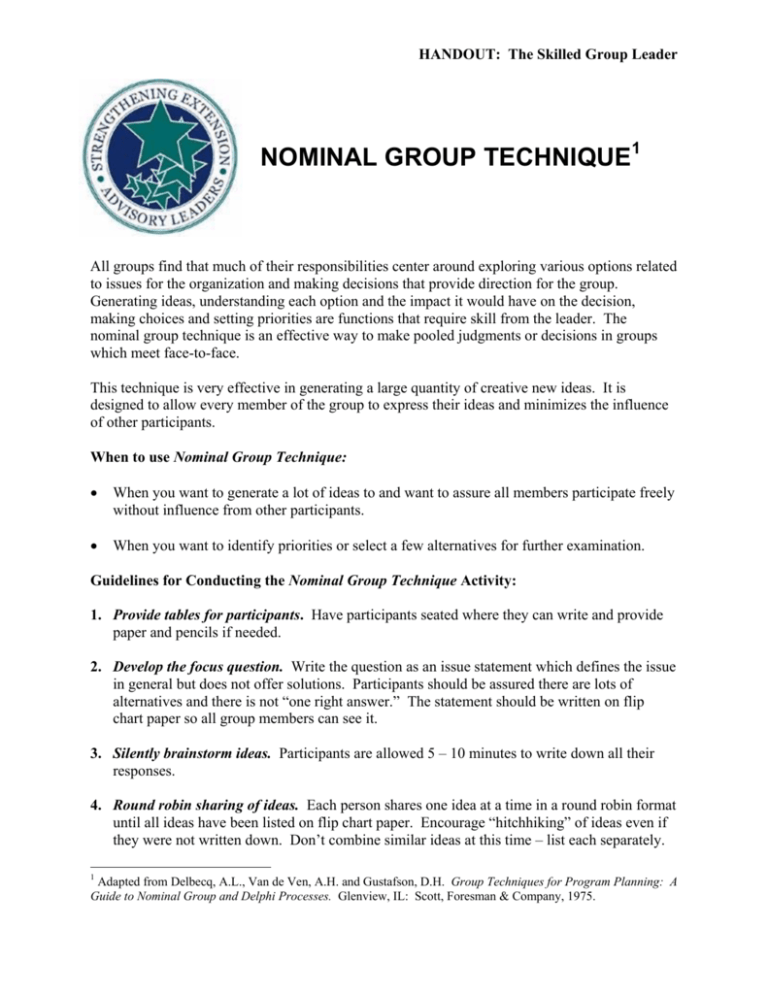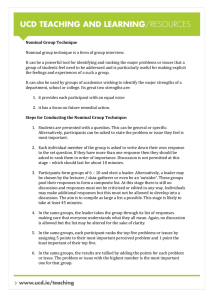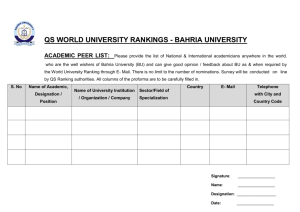Nominal Group Technique - Program & Staff Development
advertisement

HANDOUT: The Skilled Group Leader NOMINAL GROUP TECHNIQUE1 All groups find that much of their responsibilities center around exploring various options related to issues for the organization and making decisions that provide direction for the group. Generating ideas, understanding each option and the impact it would have on the decision, making choices and setting priorities are functions that require skill from the leader. The nominal group technique is an effective way to make pooled judgments or decisions in groups which meet face-to-face. This technique is very effective in generating a large quantity of creative new ideas. It is designed to allow every member of the group to express their ideas and minimizes the influence of other participants. When to use Nominal Group Technique: • When you want to generate a lot of ideas to and want to assure all members participate freely without influence from other participants. • When you want to identify priorities or select a few alternatives for further examination. Guidelines for Conducting the Nominal Group Technique Activity: 1. Provide tables for participants. Have participants seated where they can write and provide paper and pencils if needed. 2. Develop the focus question. Write the question as an issue statement which defines the issue in general but does not offer solutions. Participants should be assured there are lots of alternatives and there is not “one right answer.” The statement should be written on flip chart paper so all group members can see it. 3. Silently brainstorm ideas. Participants are allowed 5 – 10 minutes to write down all their responses. 4. Round robin sharing of ideas. Each person shares one idea at a time in a round robin format until all ideas have been listed on flip chart paper. Encourage “hitchhiking” of ideas even if they were not written down. Don’t combine similar ideas at this time – list each separately. 1 Adapted from Delbecq, A.L., Van de Ven, A.H. and Gustafson, D.H. Group Techniques for Program Planning: A Guide to Nominal Group and Delphi Processes. Glenview, IL: Scott, Foresman & Company, 1975. HANDOUT: The Skilled Group Leader 5. Discuss and clarify all ideas on the flip chart. Each idea is fully discussed. Participants are encouraged to share thoughts, both pro and con about items. Everyone in the group should be clear on the meaning of each item. Ask contributors to further explain if necessary. If the contributors agree some ideas are the same, delete duplication. However, combining of two or more ideas into one should not be done at this time. Number each alternative. 6. Ranking of alternatives. Each group member is asked to rank order their top ten alternatives. Ten being the most important. This may be done by having participants write the rank beside the idea directly on the flip chart or by listing the idea on a 3X5 index card and writing their rank in the bottom right corner of the card. The facilitator collects the cards and records each ranking beside the alternative, assuring anonymous rankings. The ranks for each alternative are averaged NOTE: When dealing with a large number of items, it may be necessary to narrow the list through using the Multi-Voting or 100 Votes procedures. 7. Ranked items are discussed. All items receiving a rank are listed so all participants can view. The ranking of each item is designated. (The higher the total, the higher the rank.) Further discussion and clarification of the ranked items is led by the facilitator to ensure that all participants understand what is meant by each priority. 8. 2nd Ranking. From among the ranked items on the previous list, each participant ranks the ten items he now considers most important. This is done silently and independently as in step 6. (This ranking might be limited to five items per person.) The rankings are again averaged. 9. Final rankings are discussed. The group reviews the ranking and discusses the outcome of the activity. 10. Format for sharing results. Create a table listing all ranked items, beginning with the item ranked the highest. Include a column indicating the total votes each item received and the number of persons casting a vote for that item. 2











